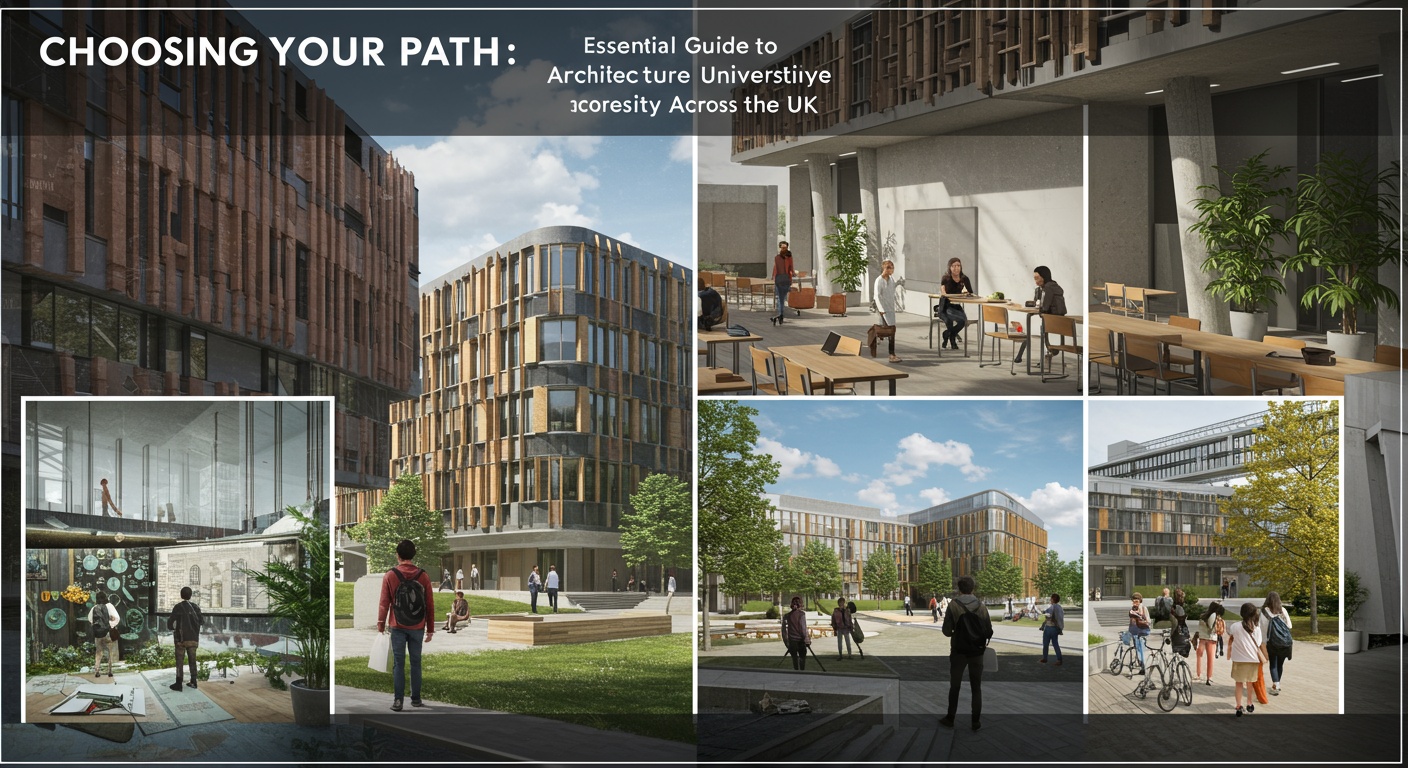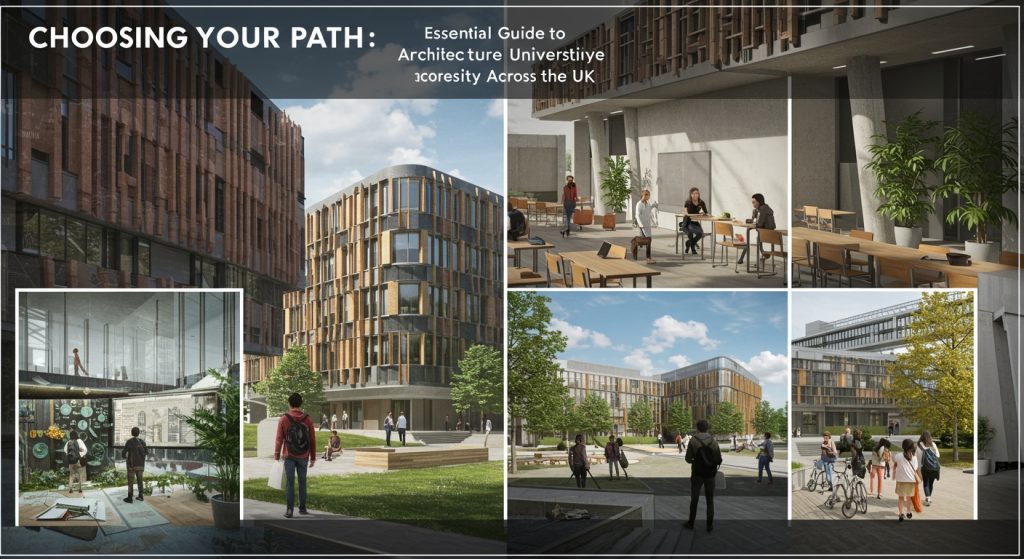The decision to pursue architecture launches a transformative journey, demanding a meticulous choice among the world-class architecture universities UK provides. Beyond traditional studio culture, today’s top programmes – from Glasgow School of Art’s focus on material innovation to Sheffield’s urban regeneration projects – immerse students in crucial contemporary challenges. Think about how institutions address net-zero carbon design principles, integrate advanced digital fabrication techniques, or explore the impact of AI on conceptualisation. Your university selection is pivotal, setting the stage for developing a portfolio that reflects both artistic vision and technical acumen, equipping you for a dynamic profession constantly evolving with sustainable practices and smart city integration.

Understanding the Architectural Journey: The UK Context
Embarking on a career in architecture is an incredibly exciting and rewarding journey. Choosing where to begin this adventure is a pivotal decision. The United Kingdom boasts a world-renowned reputation for architectural education, with a diverse array of institutions offering unique approaches to design, theory. Practice. Before diving into specific institutions, it’s crucial to grasp the fundamental structure of architectural education in the UK, which is distinctly regulated to ensure a high standard of professional competency.
The path to becoming a fully qualified architect in the UK is a structured, multi-stage process governed primarily by two key bodies:
- The Architects Registration Board (ARB): This is the statutory body for architects in the UK. Registration with the ARB is legally required for anyone wishing to call themselves an “architect” in the UK. They prescribe the qualifications needed for registration.
- The Royal Institute of British Architects (RIBA): While not a statutory body, RIBA is a professional organisation that champions better buildings, communities. The environment through architecture. Many architecture universities UK programmes are validated by RIBA, signifying that they meet a high standard of architectural education. While ARB prescription is essential for registration, RIBA validation is highly respected within the profession and often aligns with ARB requirements.
The educational journey typically unfolds in three parts, often referred to as “Parts 1, 2. 3”:
- Part 1: The Undergraduate Degree (BA/BSc Architecture) – This is usually a three-year full-time course, focusing on core architectural principles, design studio work, history, theory, technology. Professional studies.
- Part 2: The Postgraduate Degree (MArch/DipArch) – Following a period of practical experience (often a “year out”), this is typically a two-year full-time Master’s or Diploma course, delving deeper into complex design challenges, research. Advanced theoretical concepts.
- Part 3: Professional Practice Examination – After further practical experience (usually another year or more), this final stage involves an examination that assesses a candidate’s competence in professional practice, management. Law. Only upon successful completion of Part 3 and meeting the ARB’s criteria can one register as an architect.
Understanding this framework is the first step in navigating the landscape of architecture universities UK has to offer. It ensures that whichever institution you choose, its programme will ultimately lead you towards professional registration.
Deciphering University Programme Structures
When exploring architecture universities UK-wide, you’ll encounter various programme titles and structures for the initial stages of your architectural education. While the end goal for professional registration remains consistent (Parts 1, 2. 3), the pathways to achieve these can differ. It’s vital to comprehend these nuances to select a programme that aligns with your learning style and career aspirations.
Part 1: The Foundation of Your Architectural Knowledge
- BA (Hons) Architecture or BSc (Hons) Architecture
- BA (Bachelor of Arts)
- BSc (Bachelor of Science)
These are the most common undergraduate degrees, typically lasting three years.
Often indicates a stronger emphasis on the humanities, history, theory. Cultural aspects of architecture. Programmes might encourage more conceptual and artistic approaches to design.
Typically suggests a greater focus on the technical, scientific. Technological aspects of building design, including structural engineering, environmental science. Construction.
While these distinctions exist, many programmes blend both arts and science elements. What truly matters is that the programme is prescribed by the ARB (and ideally validated by RIBA) as fulfilling Part 1 requirements. Without this, your degree won’t count towards becoming a registered architect.
Part 2: Deepening Your Expertise
- MArch (Master of Architecture) or DipArch (Diploma in Architecture)
- MArch
- DipArch
These are the standard postgraduate qualifications fulfilling Part 2, usually lasting two years full-time.
Increasingly common, often structured as a Master’s degree with a strong research component, culminating in a substantial design thesis or project.
A more traditional qualification, often with a strong emphasis on advanced design studio work and practical application.
Many students take a “year out” between Part 1 and Part 2 to gain practical work experience in an architectural practice. This experience is invaluable for applying theoretical knowledge, building a portfolio. Understanding the realities of the profession. Some universities offer integrated Masters programmes, where Part 1 and Part 2 are combined into a longer, continuous course (e. G. , 4 or 5 years), though these are less common for architecture specifically.
Integrated vs. Separate Pathways
While most students follow the separate Part 1, year out, Part 2, year out, Part 3 structure, some architecture universities UK offer slightly different configurations:
- “Four-Year Master’s” Programmes
A few institutions offer programmes that integrate Part 1 and Part 2 into a single, longer undergraduate degree (e. G. , MEng Architecture). While seemingly efficient, it’s crucial to confirm these programmes are fully ARB-prescribed for both Part 1 and Part 2. Always check the ARB’s list of prescribed qualifications.
Understanding these structures is paramount. It allows you to plan your education effectively and ensures that the degree you pursue will genuinely lead you towards your goal of becoming a registered architect.
Key Considerations When Choosing Your University
With a clear understanding of the UK architectural education framework, the next step is to delve into the specifics that differentiate one institution from another. Choosing among the excellent architecture universities UK has to offer requires thoughtful consideration of several factors, each playing a crucial role in shaping your academic experience and future career.
Accreditation and Validation
As mentioned, this is non-negotiable. Ensure the programme you choose is ARB prescribed for Part 1. Many are also RIBA validated, which is a mark of quality and industry recognition. Always double-check the latest listings on the ARB and RIBA websites.
Pedagogical Approach and Studio Culture
Architecture schools are renowned for their ‘studio culture,’ an immersive learning environment where students develop design projects under the guidance of tutors. But, the specific approach to teaching and design varies significantly:
- Design-Led vs. Technology-Led: Some universities place a strong emphasis on conceptual design, artistic expression. Theoretical exploration, while others prioritise building science, structural integrity. Environmental performance.
- Theoretical vs. Practical Focus: Do you prefer a curriculum heavy on architectural history and critical theory, or one that’s more hands-on with workshops and construction detailing?
- Specific Unit/Studio Themes: Many institutions, especially at postgraduate level, organise teaching into ‘units’ or ‘studios’ with distinct research agendas (e. G. , sustainable design, urban regeneration, digital fabrication). Research these units to find one that resonates with your interests.
- Teaching Style: Is it project-based learning, lectures, seminars, or a blend? What is the student-to-tutor ratio in studios?
Facilities and Resources
Architecture is a highly practical and often resource-intensive discipline. Investigate the quality and availability of:
- Workshops: For model making, prototyping (laser cutters, 3D printers, CNC machines).
- Computer Labs: Access to industry-standard software (CAD, BIM, rendering, graphic design).
Common software used: - AutoCAD - Revit - SketchUp - Rhino (with Grasshopper) - Adobe Creative Suite (Photoshop, Illustrator, InDesign) - V-Ray or Enscape for rendering - Libraries: Specialised architectural collections, digital resources.
- Exhibition Spaces: Opportunities to showcase student work.
- Environmental Labs: For testing building performance, if the university has a strong sustainability focus.
Location and Environment
The university’s location can profoundly influence your architectural education and experience:
- Urban Centres: Provide rich contexts for urban design studies, easy access to architectural practices for work experience. Exposure to diverse building types and historical precedents (e. G. , London, Manchester, Edinburgh).
- Smaller Cities/Towns: May offer a more focused, campus-based experience, potentially lower living costs. Opportunities to study regional architecture or specific heritage contexts (e. G. , Bath, Cambridge).
- Access to Sites: Consider proximity to vital architectural landmarks, historic cities, or unique landscapes relevant to the university’s specialisations.
Alumni Network and Industry Links
A strong alumni network and robust industry connections can be invaluable for internships, mentorship. Future job prospects. Look for universities with:
- Active career services that specifically cater to architecture students.
- Guest lecture series featuring prominent architects.
- Opportunities for live projects or collaborations with local communities and practices.
Student Satisfaction and Support
While academic rigour is key, your well-being and overall experience are equally essential. Look at:
- National Student Survey (NSS) scores: These provide student feedback on teaching quality, assessment. Academic support.
- Pastoral care and support services: How does the university support student mental health, academic challenges. Disabilities?
- Student societies: Opportunities to engage in extracurricular activities, often including architecture-specific clubs, field trips. Events.
Portfolio Requirements
For most architecture universities UK, a strong portfolio is a crucial component of your application. It’s not just about showcasing finished art pieces but demonstrating your observational skills, creativity, spatial awareness. Passion for design. Research each university’s specific portfolio guidelines carefully.
By thoroughly researching these aspects, you can make an informed decision that sets you on the right path for a fulfilling architectural education.
Exploring Diverse Architectural Philosophies: A Comparison
The beauty of architecture universities UK is their incredible diversity in philosophical approaches. While all accredited programmes will provide a comprehensive education, their emphasis can vary significantly, shaping the kind of architect you become. Understanding these underlying philosophies is crucial for choosing a university that aligns with your personal values and design inclinations.
Here’s a comparison of some common architectural philosophies you’ll encounter:
| Philosophy / Approach | Key Characteristics | Examples of Focus Areas | Potential University Traits (Generalised) |
|---|---|---|---|
| Traditional & Contextual | Strong emphasis on architectural history, theory, conservation, craftsmanship. Designing within existing urban or historical contexts. Respect for precedent and material honesty. | Heritage design, urban conservation, classical architecture, understanding local vernaculars, hand-drawing skills. | Universities with long-standing reputations, often in historic cities. Strong humanities departments, focus on drawing and model-making. |
| Experimental & Avant-Garde | Pushes the boundaries of design, form. Material. Explores speculative futures, digital fabrication, parametric design. Critical theory. Often highly conceptual and research-driven. | Complex geometries, robotics in architecture, virtual reality, critical spatial theory, non-conventional materials. | Highly competitive, often in major global cities. Cutting-edge workshops, strong digital focus, highly theoretical and research-intensive studios. |
| Technology & Sustainability-Driven | Focus on environmental performance, energy efficiency, building physics, smart materials. Sustainable construction methods. Integration of scientific principles into design. | Passive design strategies, renewable energy systems, low-carbon materials, computational fluid dynamics (CFD), building data modelling (BIM). | Universities with strong engineering or environmental science departments. State-of-the-art labs for environmental testing, focus on performance metrics. |
| Community & Social Impact | Architecture as a tool for social change, urban regeneration, community engagement. Addressing societal inequalities. Focus on participatory design and inclusive spaces. | Affordable housing, public space design, post-disaster reconstruction, urban planning, community-led projects, humanitarian architecture. | Universities with strong links to local communities, urban studies departments. A focus on ethical practice. Often project-based with real-world clients. |
| Arts & Humanities Integrated | Architecture viewed as a cultural practice, deeply intertwined with art, philosophy, literature. Critical thought. Emphasis on representation, narrative. Drawing as a critical tool. | Architectural theory, philosophy of space, drawing as research, interdisciplinary art projects, exhibition design. | Universities with strong arts schools, often encouraging interdisciplinary collaboration. Emphasis on conceptual thinking and visual communication. |
For example, if you are fascinated by the intricate details of historic buildings and want to master traditional construction techniques, a university with a strong ‘Traditional & Contextual’ philosophy might be your ideal fit. Conversely, if you are drawn to the future of design, algorithmic architecture. Pushing technological limits, an ‘Experimental & Avant-Garde’ institution would likely be more stimulating.
Many architecture universities UK will offer a blend of these philosophies. Usually, one will dominate. Researching faculty profiles, student projects. Published research will give you a clearer picture of an institution’s prevailing ethos. This deeper dive into philosophical leanings is essential for finding your perfect match among the many excellent architecture universities UK has to offer.
Crafting Your Compelling Application
Once you’ve narrowed down your list of preferred architecture universities UK, the next critical step is to submit an application that truly stands out. For architectural programmes, this typically involves a strong personal statement and, most crucially, a compelling portfolio.
The Personal Statement: Your Architectural Voice
This is your opportunity to articulate your passion for architecture, demonstrate your understanding of the discipline. Explain why you are a suitable candidate for the specific course and university. Admissions tutors are looking for genuine enthusiasm, critical thinking. A clear understanding of what studying architecture entails.
- Show, Don’t Just Tell
- Reflect on Experiences
- Demonstrate Skills
- Connect to the Course
- Be Authentic
Instead of saying “I love architecture,” describe why you love it. What buildings inspire you? What problems do you want to solve through design?
Have you visited significant architectural sites? Read relevant books? Attended workshops? Discuss what you learned from these experiences.
Mention any relevant skills you’ve developed, such as drawing, model making, problem-solving, or critical analysis.
Research the specific programme’s modules, ethos. Faculty research interests. Explain how your interests align with what the university offers.
Let your personality and genuine curiosity shine through.
Actionable Takeaway: Start drafting your personal statement early, allowing ample time for multiple revisions and feedback from teachers or mentors.
The Portfolio: Your Visual Story
Your portfolio is arguably the most essential component of your application to architecture universities UK. It’s not just a collection of pretty pictures; it’s a visual narrative of your creative process, observational skills. Potential as a designer. Admissions panels are looking for evidence of:
- Observational Skills
- Creativity & Imagination
- Problem-Solving
- Range of Media
- Process, Not Just Product
Show drawings or sketches of everyday objects, spaces, or buildings that demonstrate your ability to see and interpret the world around you.
Include personal projects, perhaps a conceptual design for a space, or artistic pieces that showcase your unique vision.
If you’ve undertaken any design challenges (even simple ones like designing a new layout for your room), show your thought process and solutions.
Demonstrate proficiency in various media – hand drawing, painting, sculpture, photography, digital work, model making. This shows versatility.
Include sketches, working models. Iterative designs. Admissions tutors want to see how you think and develop ideas, not just polished final pieces.
Real-world Example: I once reviewed a portfolio from a prospective student who included a series of sketches documenting the changing light patterns in their kitchen throughout a day. It was simple, yet it powerfully conveyed their acute observational skills and sensitivity to space and light – qualities highly valued in architecture.
Common pitfalls to avoid include submitting only finished art pieces without showing process, including too many pieces that look similar, or having a portfolio that is poorly organised or difficult to navigate.
Interviews: Articulating Your Vision
Many architecture universities UK will invite shortlisted candidates for an interview. This is your chance to expand on your portfolio, discuss your personal statement. Engage directly with faculty members.
- Be Prepared to Discuss Your Portfolio
- Research the University
- Ask Thoughtful Questions
- Show Enthusiasm & Curiosity
Know every piece inside out. Be ready to explain your intentions, challenges. Learning from each project.
Show that you’ve done your homework on their specific programmes, faculty. Research interests.
This demonstrates your engagement and genuine interest.
Admissions tutors want to see if you have the drive and intellectual curiosity required for the demanding nature of architectural study.
By dedicating significant time and effort to these application components, you significantly enhance your chances of securing a place at one of your chosen architecture universities UK.
Beyond the Classroom: Real-World Exposure and Future Prospects
Studying architecture is not just about mastering design software or understanding structural principles; it’s about developing a holistic understanding of how buildings shape lives and environments. The journey through architecture universities UK is designed to equip you with a wide array of skills, preparing you for a dynamic and evolving profession.
The Invaluable “Year Out” (Practical Experience)
A distinctive feature of UK architectural education is the mandatory practical experience periods, particularly the “year out” between Part 1 and Part 2. This is not just a break from studies; it’s a crucial period of professional development. During this time, you’ll typically work in an architectural practice, applying your academic knowledge to real-world projects. This experience is invaluable for:
- Understanding Practice Dynamics
- Developing Technical Skills
- Building Your Professional Network
- Informing Your Part 2 Studies
Gaining insights into project management, client communication, regulatory frameworks. Team collaboration within an office setting.
Learning to use industry-standard software in a professional context, producing detailed drawings. Understanding construction processes.
Connecting with experienced architects, engineers. Other consultants.
The practical experience often provides a clearer focus for your postgraduate studies, allowing you to identify areas of particular interest or specialisation.
Actionable Takeaway: Start looking for year-out placements well in advance. Networking during your Part 1 studies (through university events, guest lectures) can provide valuable leads.
Enhancing Your Journey: Societies, Competitions. Field Trips
Your architectural education extends far beyond formal lectures and studio projects. Architecture universities UK often boast vibrant student societies that organise:
- Guest Lectures
- Workshops
- Design Competitions
- Field Trips
Featuring leading architects, designers. Thinkers from around the world.
On niche software, fabrication techniques, or specific design methodologies.
Opportunities to test your skills against peers and gain exposure. These can range from small internal university challenges to national or international competitions.
Both within the UK and internationally, offering direct experience of significant architectural sites, urban contexts. Construction processes.
Engaging in these extracurricular activities not only enriches your learning but also helps build your portfolio, develop soft skills. Expand your professional network.
Diverse Career Paths and the Path to Registration
Upon completing Part 3 and registering with the ARB, you officially become a qualified architect. But, the skills you acquire from architecture universities UK open doors to a much broader range of career paths than just traditional architectural practice. While many graduates do pursue roles in private architectural firms, others venture into:
- Urban Design and Planning
- Conservation and Heritage
- Interior Design
- Set Design
- Architectural Journalism or Photography
- Project Management
- Academia and Research
- Sustainable Design Consultancy
Shaping cities and public spaces.
Working with historic buildings and sites.
Focusing on the internal spaces of buildings.
For film, theatre, or television.
Communicating architecture to a wider audience.
Overseeing construction projects from inception to completion.
Teaching the next generation or conducting architectural research.
Specialising in environmental performance and green building.
The journey from a prospective student to a registered architect is long and rigorous, typically taking a minimum of seven years (3 years Part 1 + 1 year experience + 2 years Part 2 + 1 year experience + Part 3 exam). But, it is a deeply rewarding path that equips you with a unique blend of creative, technical. Problem-solving skills, preparing you to shape the built environment and make a lasting impact.
Conclusion
Choosing your architecture university is far more than just picking a name from a league table; it’s about aligning your aspirations with an institution’s unique ethos and specialisms. Rather than solely focusing on rankings, delve into what truly matters: does the programme integrate current trends like climate resilience, sustainable design, or cutting-edge digital tools such as BIM and AI, as seen in innovative projects across the UK? My personal tip is to deeply explore each university’s studio culture and research focus – this is where your passion will truly ignite and your skills will be forged. Connect with current students and recent graduates; their lived experiences offer invaluable insights beyond any prospectus. Remember, your journey into architecture isn’t merely about obtaining a degree; it’s about laying the foundation to critically think, design. Ultimately shape the built environments of tomorrow. Embrace this pivotal decision with confidence, knowing you are stepping into a profession that profoundly impacts lives and landscapes.
More Articles
Designing Your Career: A Guide to the Top Architecture Universities in the United Kingdom
Unlocking Your Future: Discover the Best Architecture Universities in the UK for 2025
Build Your Biotech Career: Essential Skills and Education for Success in 2025
Navigate Your Future: Top Biotechnology Career Paths and Salary Insights
FAQs
So, I’m thinking about studying architecture in the UK. Where do I even begin with this guide?
This guide is your starting point! It breaks down key aspects like understanding different university types, what to look for in a program. How to prepare your application. Think of it as a roadmap to finding your perfect fit among the UK’s diverse architecture schools.
What should I really be looking for in an architecture program? Is it just about rankings?
Not at all! While rankings give you a general idea, focus more on things like professional accreditation (like RIBA validation), the studio culture, available facilities (workshops, digital labs). The specific design philosophies or research areas of the faculty. A program that aligns with your interests will serve you better than just a high-ranked one.
Does it matter if the university is in a big city or a smaller town? How does location affect my studies?
Location can definitely impact your experience. Big cities often offer more opportunities for internships, part-time work. Exposure to diverse architectural styles and practices. Smaller towns or campus universities might provide a more focused, quieter environment with a strong community feel. Consider your lifestyle preferences and career aspirations when weighing this up.
Everyone talks about portfolios. How vital are they for architecture applications?
Your portfolio is super crucial! It’s your chance to showcase your creative potential, problem-solving skills. Passion for design, even if you don’t have formal architecture experience. It doesn’t have to be perfect. It should demonstrate your observational skills, ability to develop ideas. A willingness to experiment. Most universities will give it significant weight.
What kind of grades or subjects do I need to get into these universities?
Entry requirements vary a lot. Generally, universities look for strong academic performance, often with specific requirements in subjects like Math, Physics, or Art/Design, depending on the course. Always check the individual university’s prospectus for their exact UCAS points or A-level/IB requirements, as some might be more flexible if you have a compelling portfolio.
Are all architecture degrees the same, or are there different types I should know about?
There are indeed different types! The standard path in the UK usually involves a three-year Bachelor’s degree (like a BA or BSc), which gives you RIBA Part 1. After that, you’ll typically need to complete a Master of Architecture (MArch) or similar postgraduate degree (RIBA Part 2), followed by a year of professional experience and a final exam (RIBA Part 3) to become a fully qualified architect. The guide clarifies these stages.
What if I’m not super artistic or haven’t done much art before? Can I still study architecture?
Absolutely! While creativity and visual communication are key, you don’t need to be a traditional ‘artist.’ Architecture is a blend of art, science. Technology. Universities are often looking for critical thinking, problem-solving abilities. An interest in built environments. Your portfolio can show diverse skills, not just drawing. Many successful architects come from varied backgrounds.



